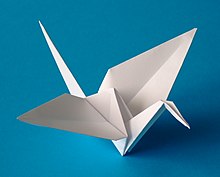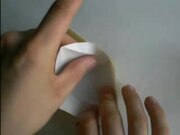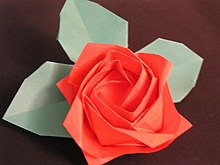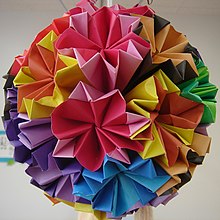origami

The Origami ([ oʀiɡaːmi ] () Japanese. 折り紙 [ oriˌɡami ] ; of oru for "fold" and kami for " paper ") is the art of paper folding. Starting from a mostly square sheet of paper, folding creates two or three-dimensional objects such as B. Animals, paper planes , objects and geometric bodies.
Historical background
Even before the invention of paper (around 100 BC in China ), fabrics and other materials were folded.
In 610, the paper was brought from China to Japan by Buddhist monks , where paper folding experienced a first flowering in the Muromachi period (1333–1568) and a second flowering in the Edo period (1603–1868). Since paper was quite expensive at the time, it was probably reserved for ceremonial folds, such as that used by Noshi in the Muromachi period.
Independently of this, the European art of paper folding developed, spreading from Egypt and Mesopotamia to Spain in the 16th century and later to Western Europe. For a long time only a small number of traditional models were known in origami, such as B. the crane (Japan) or the pajarita (Spain). It was not until the Japanese Akira Yoshizawa (1911–2005) broke with traditional templates and created new models. He developed a system of simple systematic drawings ( called diagrams ) to create folding instructions that could be passed on and generally understood. This system is the basis for the Yoshizawa-Randlett system , the notation used today for folding instructions.
Within a short period of time there was a revolution in origami, producing models with a complexity that was previously not thought possible. The so-called "Bug Wars" played a major role in this in the 1960s, a friendly competition between several butterflies (e.g. Robert J. Lang ) with the aim of folding beetles and insects as lifelike as possible.
Modern origami models are sometimes very complex and often take several hours to fold. On the other hand, many origami adults still prefer simple structures and shapes today; some butterflies also specialize in very specific models (e.g. boxes).
According to a Japanese legend , whoever folds a thousand origami cranes ( 千 羽 鶴 , Sembazuru ) will receive a wish from the gods. Since the death of the atomic bomb victim Sadako Sasaki , who fought in vain against her radiation-induced leukemia by folding cranes , origami cranes have also been a symbol of the international peace movement and resistance to nuclear war.
Conditions for a two-dimensional origami object
In order for a model to be flat or level when folded, the associated folding plan must meet the following conditions:
- The number of all folds must be even
- Must or be ( = mountain fold, = valley fold; Mackawa / Justin)
- Must be the local minimum of a wedge between a mountain and a valley fold
- When calculating the degrees of wrinkles, the result must be 0 °. Example with four folds:
- Do the different folds (in a four-knot) have to face each other in this constellation: and . This means that z. B. is a mountain and a valley fold, while and both are mountain folds .
Parts of origami
Today there are several different directions in origami, which can also be mixed with each other.
- Classic origami: a piece of paper, usually square
- Modular origami (sometimes called tangrami): Several identical parts are put together to form a model, e.g. B .:
- Box folds ( Tomoko Fuse is an expert in this field ).
- Polyhedra : Sometimes different parts are used here (e.g. connecting pieces and surfaces).
- Tangrami: also known as 3D origami, is particularly widespread in China, where a large number of mostly similar modules are put together to form different models.
- Multipiece origami: Different parts are put together to make dolls and the like (often with the use of glue).
- Boxpleating: By folding horizontal and vertical lines that change direction along 45-degree angles, it is possible to have any number of free layers that can then be shaped into all sorts of legs, arms, etc.
- Iso Area: The finished model looks the same from all sides.
- Pureland: Only mountain-and-valley folds (the basic folds in origami) may be used.
- Tessellations (from the English for mosaic ): flat folded pictures with repeating patterns
- Wetfolding: The folding of slightly moistened paper in order to better shape models. The finished (dried) models are very stable and look more natural. Some butterflies use very sturdy paper such as elephant skin or watercolor paper , others use extremely thin tissue paper or similar paper that has previously been treated with methyl cellulose (wallpaper paste) to make it easier to shape.
- Kirigami: folds with incisions
- Crumpling: A folding method made famous by the French Vincent Floderer . First a certain “base” is folded, which is then deliberately crumpled and carefully shaped.
- Kinetic origami: spirals are created that can be rotated at will.
Paper types
Traditionally, square paper in standard sizes of 7.5 cm, 15 cm, 18 cm, 20 cm and 25 cm side length is used to fold origami models. Other sizes from 2.5 to 70 cm are available, but 15 × 15 cm is the most common side length. A distinction must be made between hand-made paper ( Washi ) and industrially produced paper (Kami) . Classic origami paper is printed with one color on one side; the back is white. Full-color papers (front and back are the same color) are the most common in German retail, but there are also papers that are differently colored or patterned on both sides. In well-stocked origami shops you can also find special types of paper, such as tissue foil, elephant skin , Tant, Lokta, Unriyu and many others. Particularly for more complex models, particularly thin, resistant papers such as tissue foil are ideal.
Techniques and basic forms
Basic folding techniques that are often repeated in origami are:
- Mountain folding
- Valley fold
- Pinch fold
- Zigzag fold
- Inverse folding outwards or inwards
- Rabbit ear fold
- Petal fold
- Kink fold
- Vertical folding.
A model usually begins with a so-called base (basic shape). The classic basic forms are:
Overall, there are many more basic forms today; these six basic shapes are called "classic" because they have been used for centuries. Since the complexity of the models is limited with these basic forms, more and more basic forms have been developed recently. These are often only developed for a specific model and some of them are quite complex. Simple origami models usually require 10 to 30 folding steps and are therefore usually not as true to life. The newer, super-complex models from the special bases, on the other hand, often have up to 300 folding steps and are usually very similar to the original.
Application in education and therapy
To view origami not only with an artistic, but also with an educational approach, has successfully established itself since Friedrich Fröbel , who adopted the art of paper folding from Japan in the conception of his kindergarten. Working with children on paper has been particularly successful in therapeutic settings, kindergarten and school. In Japan and Israel there are schools with origami as a subject, including a theoretical and conceptual foundation. The educators Dina Vardi and Miri Golan have made a particular contribution here .
In addition to improving fine motor skills, learning how to work accurately, following instructions and recognizing geometric relationships, concentration is the central component that can be promoted with the help of origami. A second educational-therapeutic added value is the strengthening of social skills in the areas of togetherness, communication, perception of others and self-control. Since it is not about speed, but the creative-aesthetic aspect and of course the fun of creating is the focus, there is no competition between each other, or it is quickly abandoned there. Small groups that are heterogeneous in terms of skills are particularly suitable - this is where the opportunity for mutual motivation and support for individual self-esteem building is greatest.
Application in technology and mathematics
While folding paper is about creating a 3D object from a surface, the basic techniques can also be reversed in order to fold a 3D object as compactly as possible for transport purposes. Application examples range from solar sails (see Miura folding ) to airbags and stents .
Mathematical research on origami was carried out by Erik Demaine at the Massachusetts Institute of Technology (MIT) , among others . Toshikazu Kawasaki also made a significant contribution to mathematical origami research with the Kawasaki Theorem .
The American Robert J. Lang has developed two computer programs with the help of mathematical methods that are supposed to make it easier for advanced folders to design their own models:
- TreeMaker
- Based on a line drawing of the model, the program calculates a folding pattern with the correct number of tips (basic shape), which can then be transformed into the desired model with a lot of experience.
- ReferenceFinder
- A folding sequence for reaching a specific reference point is determined on the basis of the coordinates.
Organizations
In Germany, interested parties founded the Origami Germany Association in 1989 . In the German-speaking area there are also the national organizations Origami Austria and Origami Switzerland . Other important organizations can be found in Japan , the UK and the USA . The over 60 origami groups from different countries and continents are internationally networked.
Personalities
- Akira Yoshizawa (1911–2005): founder of the modern art of folding
- Satoshi Kamiya (* 1981): The Japanese has devoted himself to what is known as “super complex origami”. Above all, he models figures that should look as lifelike as possible. His works usually have more than 200 folding steps.
- Eric Joisel : The Frenchman also created very complex models that are predominantly fantasy figures . He liked to use the wetfolding technique. He described his 12-piece dwarf orchestra as his life's work.
- Robert J. Lang (* 1961): The physicist wants his figures - mostly animals, especially insects - to look as anatomically correct as possible.
- Brian Chan teaches the so-called “Hobby Shop” at MIT and specializes in complex crawling animals. His most famous work is the MIT logo.
- Sadako Sasaki (1943–1955): A girl who, in 1955, tried to fulfill her wish to stop suffering from leukemia with the help of 1,000 folded cranes.
Related articles
literature
- Eric Kenneway: Origami complete . Augustus Verl., Augsburg 1991, ISBN 3-8043-0165-7 .
- Kunihiko Kasahara, Toshie Takahama: Origami for the Connoisseur . 6th edition, Japan Publications, Tokyo (Japan) 1998, ISBN 4-8170-9002-2 . (English)
- René Lucio, Jan Spütz: The great origami book . 4th edition, Urania-Verl., Berlin 2003 (= design with paper), ISBN 3-332-00914-1 .
- Robert J. Lang : Origami design secrets. Mathematical methods for an ancient art . Reprint, AK Peters Ltd., Wellesley (Massachusetts / USA) 2007, ISBN 1-56881-194-2 (English).
- Robert Geretschläger: Geometric Origami . Arbelos Publishing, Shipley 2008, ISBN 978-0-9555477-1-3 (English).
- Gerwin Sturm: Origami. Creative folding ideas . 1st edition, Christopherus Verl., Stuttgart 2008, ISBN 978-3-419-53472-4 .
- Armin Täubner: Tangrami for children: fold and stick paper . 1st edition, Frech-Verl., January 2009, ISBN 978-3-7724-5812-5 .
Web links
- The origami code - researchers discover folding , video documentation on 3sat, accessed on November 5, 2016
- Origami Simulator , interactive simulator including mathematical background information (English)
Individual evidence
- ↑ Vanda Battaglia, Francesco Decio and Sam Ita: Japanese Origami for Beginners Kit: 20 Classic Origami Models. Tuttle Publishing, Tokyo , 2015. page 7. ISBN 978-0-8048-4543-4 .
- ^ Joseph O'Rourke, How to Fold It: The Mathematics of Linkages, Origami, and Polyhedra . Cambridge University Press, 2011, ISBN 978-1-139-49854-8 ( limited preview in Google Book Search).
- ↑ happyfolding.com: Paper Reviews
- ^ Robert J. Lang: Origami Design Secrets. Mathematical Methods for an Ancient Art . Second Edition, AK Peters / CRC Press 2011, p. 55, ISBN 978-1-4398-6774-7 .
- ↑ TreeMaker by Robert J. Lang Artist's website. Retrieved July 20, 2015.
- ↑ ReferenceFinder by Robert J. Lang Website of the artist. Retrieved July 21, 2015.
- ↑ Origami Austria
- ↑ Origami Switzerland
- ^ Japan Origami Academic Society
- ^ The British Origami Society
- ↑ Origami USA
- ↑ International Community Origami Groups






























